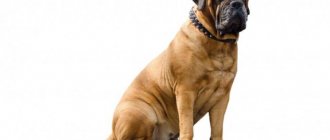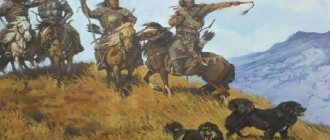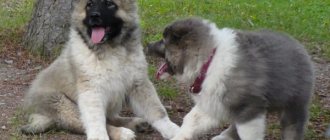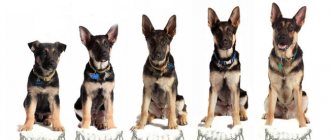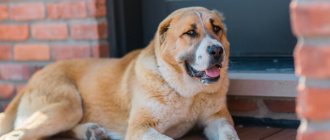Tibetan Shepherd: description of the breed
The Tibetan Shepherd or Tibetan Mastiff is an excellent guard dog. These are strong animals, with a height of 60-65 cm reaching a weight of 60-70 kg.
The breed is famous for its thick coat with a double undercoat, which perfectly protects the animal in winter. The thick hair in the neck area visually resembles a mane, which is why the Tibetan Shepherd Dog has the nickname “Tibetan lion”.
The coat color varies from gray-blue to deep black. There are also individuals with various red shades. There are white areas on the chest and paws.
Origin story
The Tibetan Mastiff has been surrounded by myths and legends since ancient times. The breed itself is quite ancient, formed as a result of the geographical isolation of Tibet.
Since the 13th century, when Chinese merchants passed through the territory of Tibet, the gene pool of local and Chinese dogs began to mix. Purebred Tibetan dogs remain only among those living in the mountains.
The first mentions of these strong and hardy animals begin to appear centuries BC. In the 13th century, during his travels to Asia, Marco Polo described these dogs admiringly. They were brought to Europe in 1847.
Tibetan mastiffs amazed European residents with their appearance, which is why the first individuals brought there were kept in zoos.
Many dog handlers study Tibetan mastiffs with interest. Some of them even express the opinion that this breed can be considered the ancestor of the Molosser (this is a group of dog breeds that includes Great Danes, Bulldogs, Mastiffs, Boxers, Pugs).
Show breed standards
The breed standards for the Tibetan Mastiff are not spelled out in much detail.
Some individuals within the breed differ markedly from each other in color and size. The minimum height for males is 66 cm, for females - 61. Different variations in color are allowed: black, gold, chestnut, red and gray with tan.
The Tibetan Shepherd (photo) is the largest dog of all the ancient breeds on Earth. She has a powerful muscular body, a strong neck with a slight bend and mane, strong, evenly placed limbs. The tail is of medium length, set above the level of the back line, curved. The head is wide, with a massive and strong skull. The ratio of skull to muzzle is 1:1.
The eyes are medium-sized, far apart, expressive. The ears are drooping, triangular in shape, low set and close to the head.
Dog breed Tibetan Mastiff
If you want a non-aggressive and excellent watchdog, then choose this breed. Mastiffs get along well with children, protecting them from everything around them. At the same time, the characteristics of the Tibetan Mastiff breed indicate that the animals are willful, therefore, for proper education, it is important to work with them. The pet will be wary of strangers in order to stand up for its owner if necessary. There are several varieties of these dogs, with their own characteristics, but they all have several common points in common: friendliness, vigilance and balance.
Tibetan Mastiff - history of the breed
There are no clear facts explaining the origin of the breed, but there are several assumptions. According to one version, the ancestors of these animals are Tibetan wolves, and in another history of the origin of the Tibetan Mastiff breed it is said that it has roots from the watchdogs of merchants traveling through Tibet. They were first mentioned in the book of Shu King (1121 BC). It says that mastiffs were guards of monks' houses, monasteries and livestock.
Tibetan Mastiff - description of the breed
This breed is distinguished among others by its huge size and muscular build. Basic standards of the Tibetan Mastiff breed:
- An adult male weighs about 70 kg, but his height at the withers is about 70 cm, and as for females, their weight reaches 60-65 kg, and their height is about 60 cm.
- Mastiffs have a wide and heavy head and neck with well-developed muscles. The bite is powerful and the muzzle is moderately wide.
- The massive and muscular body has a straight top line and a chest that is deep set.
- To understand what a Tibetan mastiff looks like, the characteristics of the breed also indicate that the pet’s body is covered with long and coarse hair with a thick undercoat.
- Oval eyes are set wide apart and can be brown or dark. The ears of these animals are triangular in shape and drooping. Their paws are strong and even, and their tail is long and bushy.
- The characteristics of the breed indicate that there are three main colors: black, red and tan (black with brown spots). The standards allow for the presence of a small white spot on the chest.
Tibetan Mastiff - character
Animals of this breed are suitable for families with children, since they do not single out a single owner and treat everyone equally, showing love and affection. They are sensitive and get upset when their owners argue. The main character traits of the Tibetan Mastiff dog:
- In the presence of family members, animals do not show aggression towards guests if they behave appropriately. At the same time, they are distrustful of strangers.
- The characteristics of the breed indicate that Tibetan mastiffs have high intellectual abilities and are often stubborn.
- Animals have a calm and balanced character, and they do not show anger without reason.
- They adapt easily to the family and love attention. They can never leave their owner's side.
Tibetan Mastiff - life expectancy
Animals of this breed have excellent health, so they rarely get sick. The lifespan of a Tibetan Mastiff depends on whether all rules regarding maintenance are followed or not. If everything is in order, then the pet can live up to 10-14 years. Large dogs endure heavy loads every day and their bodies wear out quickly, so carefully monitor your pet’s health. It is recommended that you visit your veterinarian regularly and have an x-ray done once a year.
Character
The character of the Tibetan Shepherd harmoniously combines patience and fearlessness, which makes it an ideal home protector. However, like every breed, it also has its own behavioral characteristics that future owners should take into account.
The character of the Tibetan Mastiff is sometimes distinguished by stubbornness and independence, so it is very important that the dog, from puppyhood, learns not only to obey, but also to trust its owner.
The Tibetan Shepherd (photo in the article) loves communication and attention, so it is perfect for keeping in a family. Despite their patient nature, it is better not to let small children near the animal, because overly active behavior typical of children can be mistaken by a guard dog for aggression against itself.
Tibetan mastiffs also do not approve of large gatherings of strangers in the house. Therefore, lovers of noisy and crowded parties should not get a dog of this breed. This attitude is typical for all breeds of dogs with guarding qualities.
During walks, it is necessary to adhere to different routes, otherwise the mastiff will consider someone else’s territory to be its “protection zone.”
If a Tibetan Shepherd dog is kept in the yard most of the time, it is necessary to fence the area with a fairly high fence.
It is not recommended to leave the Tibetan Mastiff alone for a long time or with unfamiliar people. A naturally sociable dog can harbor a grudge and stop trusting its owners, or even go wild.
Nutrition
The Tibetan Mastiff can be fed with food or natural products at home. Cooking food from natural products takes more time and effort. So that the dog’s diet is compiled correctly. At least a third of all food should be pure protein. Meat, offal, yogurt, kefir, and cottage cheese are used. Fermented milk is allowed - whole milk is not allowed. Lactose intolerance is not uncommon among representatives of the breed.
Ready-made food should belong to the premium or holistic classes. They contain essential proteins, microelements, and vitamins. It is important to supplement natural nutrition with vitamins for dogs; they can be added directly to porridges and soups for dogs. Normally, an adult mastiff reaches the weight of an adult - up to 73 kg or more.
Features of care and maintenance
Given the size and character of the Tibetan Mastiff, it is best to keep it in the spacious yard of a private house, where it can play and move around to its heart's content.
The thick double undercoat creates certain difficulties for keeping the animal in a hot and humid climate. The Tibetan Shepherd Dog tolerates high temperatures well only when kept in a dry climate.
Every day it is necessary to provide the dog with walks and active games lasting at least half an hour. When walking with a puppy, the owner must be extremely attentive and careful. The fact is that it is during the period of growing up that most limb injuries occur, so outdoor games with a small mastiff are best spent in familiar terrain, for example, in the yard of a house.
The Tibetan Mastiff usually sheds once a year, depending on the climate. The dog must be brushed several times a week with a special grooming brush. Tangles need to be untangled by hand or cut off. Bathing is carried out once a month and as needed.
Proper and timely care will ensure a long and healthy life for your pet.
Tibetan Mastiff - conditions of detention
Large breeds need an area to roam. A private home is best suited for them, and in the case of apartment housing, you will have to take your pet outside 3-4 times a day for at least 30-40 minutes. The peculiarities of keeping a Tibetan mastiff are associated with the huge size of the animal and the presence of thick hair. It should be borne in mind that dogs do not have sweat glands, so in the heat it is important for them to have shade, or at best, coolness.
Tibetan Mastiff - keeping in an apartment
If you want to become the owner of this large dog, then you can keep him in an apartment, although this is not considered an ideal option. A Tibetan Mastiff can live in an apartment if there is enough room space.
- The dog should have room to sleep comfortably in a position that suits him.
- In addition, there must be a place for the pet in all rooms so that it can sit next to its owner.
- To keep a Tibetan mastiff in an apartment, the characteristics of the breed show that a place for feeding must be allocated in the kitchen or other place so that the animal can stand upright and be comfortable.
Keeping a Tibetan Mastiff in a private home
Many people living outside the city choose large breeds, and if you plan to keep your pet outside, you will have to build an enclosure. If you are wondering whether it is possible to keep a Tibetan Mastiff on a chain, then the answer is no, since the dog is territorial and must run around the area. When organizing an enclosure, consider the following features:
- The size of the enclosure is at least 2x3 m and 2 m in height. It should be divided: 1/3 part - a booth and a bed, where the floor should be covered with boards, and there should be a canopy on top, and 2/3 parts should be sown with grass or covered with sand.
- The rest area should not be filled with concrete. A roof over the resting place must be provided to protect the animal from overheating and rain.
- Even when kept in an enclosure, the pet needs daily walks.
Tibetan Mastiff as a guard
Since the ancestors of this breed are shepherds and guards, the characteristics of the mastiff breed indicate that they are ideal guards. By their very appearance they evoke respect from others, so many will be afraid to simply approach the house. The main protective qualities of the Tibetan Mastiff: fearlessness, absence of causeless aggression, self-sufficiency and determination. In addition, dogs of this breed have characteristics such as endurance, strength, and they also have a good sense of their territory and will warn about uninvited guests.
Health and illness
Owners should remember that most infectious diseases can be avoided by vaccinating their pet in advance. These procedures must be repeated annually, with revaccination at the veterinary clinic.
The Tibetan Shepherd does not suffer from diseases specific to its breed. The most common condition in dogs, including Tibetan Mastiffs, is entropion, where the lower part of the eye rolls inward. This problem can be solved relatively easily, with the help of simple surgery.
Large dogs often have joint problems, and although Tibetan Shepherds are not particularly susceptible to this disease, no one is immune to the risk of hip dysplasia. To prevent the disease, it is recommended to conduct x-ray examinations from time to time (but not more than once a year), and also carefully monitor the visual manifestations of possible diseases.
Proper nutrition of the Tibetan Shepherd
The Tibetan Shepherd, especially during the period of active maturation, eats a lot. Adult dogs need less food, but their diet should be balanced.
It is not recommended to mix ready-made dry food with natural food. A complete diet should include cereals, eggs, vegetables and meat.
Feeding should be done at regular intervals. Puppies up to six months of age should eat at least six times a day, adults - up to four times.
Basic nutritional rules to follow:
- You cannot overfeed your dog. If for some reason she is very hungry, it is necessary to provide more frequent feeding in small portions.
- Do not soak dry food in water or milk. This may lead to poisoning.
- A sudden change of food from natural food to ready-made dry food can cause digestive problems, so such a transition must be carried out gradually.
- It is necessary to choose food for your pet taking into account its age.
- Smoked, salty foods, raw fish and meat should not be given to animals.
Features of feeding and diet
Proper nutrition should accompany the Tibetan Mastiff from birth. The formation of an individual ends at four years of age; until this moment it is better to use the puppy’s feeding guide, otherwise there is a high chance of not taking into account all the subtleties of building the animal’s diet. The consequence may be weakness of the muscle corset, brittle bones (a month-old puppy must receive the required amount of calcium). Every month the amount of food consumed by the mastiff will increase - feeding is considered the most expensive part of keeping Tibetan mastiffs.
Whether to base the diet on natural food or gradually switch the animal to dry food is up to the owner of the Tibetan mastiff to decide. Mixing two types of diet is strictly prohibited, as this can lead to indigestion and other problems with the gastrointestinal tract.
If the owner decides to leave the pet on a natural diet, then he should purchase a guide on feeding an adult dog. Such manuals prescribe the norm for obtaining KBJU and microelements, an approximate diet, and also state whether the animal can consume certain foods.
Products recommended for inclusion in the diet include:
- beef;
- offal (except chicken bones);
- lean meats and poultry (rabbit, chicken, turkey);
- sea fish and seafood;
- cereal porridge;
- unsweetened vegetables and fruits;
- fresh vegetables (except starchy vegetables);
- vegetable fats (oils).
When transferring a furry giant to food, you should pay attention to the animal’s body’s reaction to the components of the food. The transition occurs slowly: at first, food is added to the food in small handfuls, then most of the food is replaced by dry food and, in the end, the animal is completely transferred to food. It is possible for the food to soften in water, especially if the puppy is being fed.
Typically, an adult Tibetan receives two servings of food per day, a puppy – three to six servings. The amount of food depends on age. Water should be available all day and should be changed every two hours.
Training
In order for a dog to be obedient, it is necessary to train it, starting from puppyhood.
The Tibetan Shepherd is a naturally intelligent and attentive dog that needs guidance and a firm hand from its owner. However, training must be carried out in such a way that the animal learns not only to obey, but also to completely trust the owner, therefore screaming or violence is unacceptable. Under no circumstances should the puppy’s natural playfulness be suppressed, otherwise he will experience a hidden fear of his owner, which may result in uncontrollable behavior in the future.
Tibetan Shepherds, like most guard breeds, need socialization - from time to time you need to introduce them to other people and dogs. If an animal is deprived of socialization, it may become overly aggressive and suspicious. Of course, in this case it is necessary to observe the golden mean - the dog should not forget about its security duties.
If an animal shows unreasonable aggression, it is necessary to seek clarification from professional dog handlers and trainers. Being practically familiar with the characteristics inherent in a particular breed, they will be able to most likely determine the reasons for this behavior of the mastiff.
Tibetan Mastiff and Caucasian Shepherd: comparison
When planning to purchase a guard dog, many future owners are faced with the choice of adopting a Tibetan Mastiff or Caucasian Shepherd puppy. Both breeds have excellent guarding qualities, but it is also necessary to take into account the specific character traits inherent in each of them.
The Caucasian Shepherd is more difficult to train, so inexperienced dog owners are better off choosing the Tibetan Mastiff. What other significant difference between them? The Caucasian Shepherd Dog versus the Tibetan Mastiff is distinguished by a more cocky and cunning disposition, while the Tibetans are more docile and calm.
Of course, the character of a dog will depend not only on its belonging to a particular breed. What matters is the upbringing and psychophysical qualities of each individual individual acquired from birth, which cannot be predicted with one hundred percent probability.
Character and habits
The first and main quality in the characteristics of the Tibetan mastiff is its extraordinary loyalty to its owners and territory. This is his instinctive quality. The Tibetan is devoted to all family members. He will become their reliable protector and patron, but will prefer a single leader, perceiving the others as his wards. The dog will selflessly protect the territory under his jurisdiction and any property owned by him.
The second point in the characteristics of the Tibetan mastiff should be noted: its extremely independent character, which requires respect. Carrot and stick training with a Tibetan is unacceptable. The dog may react to unrestrained and rude manifestations of the owner’s character by withdrawing and ignoring commands. It will be too difficult to correct the situation and establish contact with such a dog. On the other hand, the Tibetan mastiff will unquestioningly obey only the leader. It is necessary to earn the respect of the dog and its recognition as a leader in the owner. Therefore, it is recommended for experienced dog breeders to have a pet of this breed. Or you should resort to the services of a trainer.
Tibetan Mastiffs are smart and easy to train once they understand what is required of them. If contact and mutual understanding are established with them, they will willingly carry out commands. These are calm dogs with a stable psyche, but not phlegmatic. They are friendly, but their protective instincts make them wary of anyone who is not part of the family. They are not aggressive, but will not accept familiarity from a stranger. This can be understood even just by looking at a photo of a Tibetan mastiff: the dog, with its entire appearance, embodies self-esteem and nobility, and therefore relationships with it should be built on the corresponding qualities. But these pets require discipline and consistent training.
